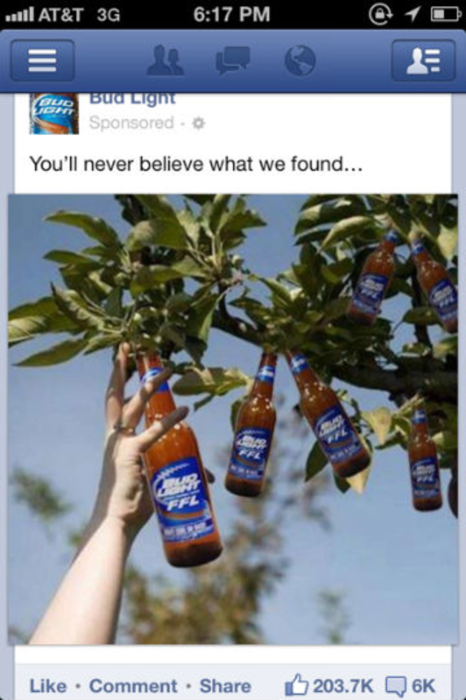Social is one channel every marketer should have on tap. Anheuser-Busch brand Bud Light has proved that to be the case by measuring whether Facebook media could drive its incremental sales.
Bud Light first launched its Facebook page in 2009 and has since accumulated more than six million fans. But just over seven months ago, the beer brand wasn’t sure if its content was reaching all of its then five million followers. To drive frequency and reach beyond its fan base, Bud Light ran a Facebook campaign from December 3 to December 31 showcasing its most engaging posts. The overall level of engagement was determined by the total number of engagements (such as picture clicks, likes, comments, and shares) divided by total people reached.
But engagement alone doesn’t contribute to a brand’s bottom line. Bud Light then used the most engaging posts to create advertisements, which were then amplified through Facebook media—primarily targeted advertising. For example, if there was an NFL-related post, Bud Light could target males in their twenties who like NFL-related pages, says Lucas Herscovici, Anheuser-Busch’s VP of digital marketing. For this specific campaign, the brand targeted Bud Light’s prime demographic, U.S. adults between 21 and 34. The two most-engaged page post ads featured a person pouring a physical Bud Light from a smartphone and a football stadium composed entirely of meat with the text “Bud Light in the fridge.”
“When we have great content, the more consumers can be exposed to that content, [and] it could impact their perception of the brand and it could drive sales,” Herscovici says. “When we do post on our page, we have the potential of reaching six million consumers, but that never happens every time. We’re not reaching six million consumers. But when we amplify that with paid media, we can be reaching many more.”
While attribution can be a challenge in any channel, Herscovici says Bud Light was able to track the campaign’s impact on in-store sales by teaming up with purchase-based data provider Datalogix. By cross referencing email addresses gleaned via consumer purchase data (sourced primarily from loyalty and credit cards) with Facebook email addresses, Bud Light was able to determine if a “person”—or rather an email address—was exposed to the page post without unveiling his or her identity.
The campaign reached 22.8 million households, and Bud Light experienced a 3.3% lift in sales among households who saw the ads compared to the control group. The brand also saw a 6X return on advertising spend, and the Bud Light smartphone ad reached 16 million unique users—an 18X increase—after the post was distributed through Facebook media.
Between 90 and 95% of Bud Light’s fans are on Facebook, and its consumers spend more time on digital compared with any other channel. That’s why Bud Light is focusing to heavily on the digital and social space.
“You could argue that we’re the original social network because beer has been with us for more than 5,000 years in connecting, bringing, and bonding people together and creating social opportunities for people,” he says. “Facebook is a great channel for us to be where our consumers are, to engage with people that want to engage with us. …consumers choose to like a brand because they have an affinity for it and they’re interested in receiving content from the brand.”
While Herscovici is satisfied with the campaign’s results, he says one thing he wishes Facebook could do better in general is measure brand impact, particularly any change in consumers’ perception of a brand.
“Did we make any more people love or prefer our brand prior to the exposure of that content?” he asks. “That was something that we were not able to do.”








